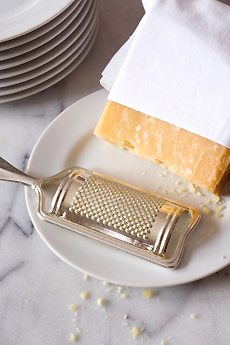TIP OF THE DAY: Multi-Task With Parmigiano-Reggiano
|
|
Parmigiano-Reggiano is more than an ingredient in pasta, pesto, risotto, Alfredo sauce and other recipes. It‘s a gourmet multi-tasker.
|
|
|
Why is Parmigiano-Reggiano spelled with capital letters? Because it’s the name of the two cities where it’s produced. More about that immediately below. WHAT’S THE DIFFERENCE BETWEEN PARMIGIANO-REGGIANO & PARMESAN CHEESE? “Parmesan” cheeses can be made anywhere in the world. But by law, authentic Parmigiano-Reggiano cheese can be produced only in the Italian provinces of Parma, Reggio Emilia, Modena, Mantua and Bologna (Parmigiano is the adjective for “of Parma”; Reggiano is the adjectival form of Reggio Emilia). The name is D.O.P-protected.* That protected flavor is well worth the price, which is more expensive than generic “Parmesan.” Informally, Parmigiano-Reggiano is called the “king of cheeses,” a title it has enjoyed for centuries. Some turophiles will note that Roquefort and Brie have also been called the “king of cheeses”; and Brie is also referred to as the “queen of cheeses.” Why such royal titles? The names resulted from different monarchs declaring their love for a particular cheese. The press and the cheese producers picked up on the endorsement and ran with it. *D.O.P is an acronym for Denominazione di Origine Protetta, a protected domain of origin that is based on numerous rules and regulations covering where and how a product can be made. It is an agricultural comparison to a trademarked brand. It means that only authentic Parmigiano-Reggiano cheese can be labeled and sold as such. This type of branding ensures consumers worldwide that each wheel of Parmigiano-Reggiano meets the same high standards (although the flavors, of course, will vary from producer to producer). The label is applied to numerous cheeses, meat and other foods that are the culinary jewels of Italy; for example, Balsamic Vinegar of Modena and Prosciutto di Parma.
|
||



